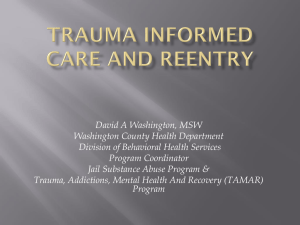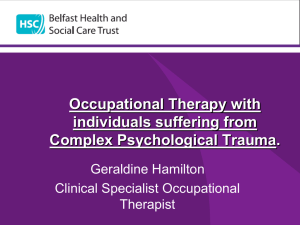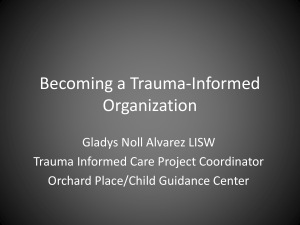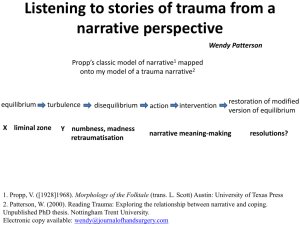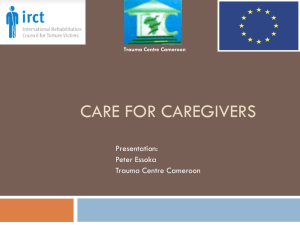The Impact of War on Children - Woodrow Wilson International
advertisement
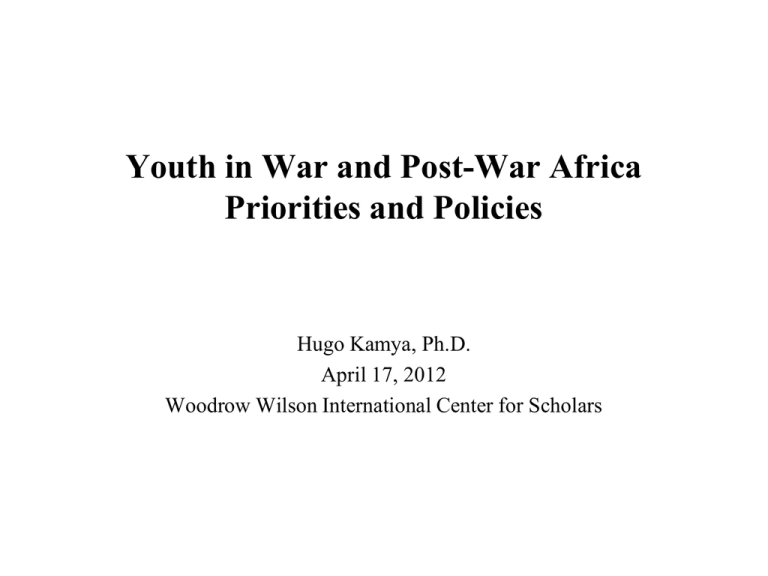
Youth in War and Post-War Africa Priorities and Policies Hugo Kamya, Ph.D. April 17, 2012 Woodrow Wilson International Center for Scholars The Impact of War on Children • • • • • • Context Northern Uganda Qualitative interviews with girls and boys Lived experiences of children Coping with consequences of war Priorities and policies Youth in Africa • Fastest growing and most youthful population in the world • Over 40% under the age of 15 • 20% between ages of 15 and 24 • Is this a “ticking, demographic timebomb?” • War and Post-War Youth complexify this serious challenge Psychological Profile • • • • • • • A sense of alienation from self and other Feelings of abandonment A threatened sense of well being and safety Feelings of vulnerability Feelings of loss and meaninglessness Experiences related to PTSD Avoidance and enduring vigilance Psychological Profile • • • • • • • Trauma as a present reality Heightened sense of alertness Fixation on trauma Body dysregulation/Fragmented memories Reduced capacity to learn escape behaviors Depression and anxiety Externalizing behaviors: aggressiveness Complex layers of loss • Systems of cooperation and mutual dependence: broken social networks • Loyalty to, and solidarity with family/kin • Interpersonal relationships • Shame, survivor and collective guilt • Disrupted social identities Other Losses • • • • Environmental effects Physical effects Neuro-developmental effects Trans-generational transmission of trauma Forces at reorganization • • • • • • “It never happened to me” stories Stories which minimize the events “It was no big deal” or “I deserved it.” Anxious attachment to caregivers Stories portraying avoidance/numbing Stories portraying children having inner imaginary companions for safety Priority and Policy Issues • Ensuring economic opportunities and stabilization • Attention to basic infrastructure services • Gender equality: empowerment of females • Ensuring security and youth participation • Cultural relevance and responsiveness to changing youth demographic • Commitment to activism & political reform Priorities and Policies • Attention to issues of access: education • Enacting and implementing laws that support and promote girl education • Community habilitation & reintegration • Policies that support health and mental health services: Cultural responsiveness • Long term monitoring, assessment and evaluation of youth programs Priorities and Policies • Human rights & humanitarian policies with clear age-based definitions of childhood • Employment opportunities, protections and employability training • Long term development geared at youth • Relief programs that include youth priorities • Social safety nets to absorb economic and social shocks Priorities and Policies • Holistic approaches to youth development • Improving physical infrastructure • Policies geared toward asset development, asset ownership and skills upgrading • Sound data and agreed upon indicators to monitor progress: conduct of research • Well monitored operational support and accountability mechanisms References Albeck, J.H. (1994). Intergenerational consequences of trauma: reframing traps in treatment theory a second generation perspective. In E.B. Williams & J.F. Sommer, Jr. (Eds). Handbook of Posttraumatic Therapy (pp. 106-125). Betancourt, T.S. & Khan, K.T. (2008). The mental health of children affected by armed conflict. Protective processes and pathways to resilience. International Review of Psychiatry, 20, 317-328. De Silva, H., Hobbs, C., & Hanks, H. (2001). Conscription of Children in Armed Conflict – A Form of Child Abuse. A Study of 19 Former Child Soldiers. Child Abuse Review, 10, 125-134. Goodman, J. (2004). Coping with trauma and hardship among unaccompanied refugee youth form Sudan. Qualitative Health Research ,14, 9, 11771196. Harkness, L.L. (1993). Transgenerational transmission of war-related trauma. In J.L. Wilson & B. Raphael (Eds.), International Book of Traumatic Stress Syndromes. New York: Plenum Press. Kamya, H. (2005). The impact of war on children and families: Their stories, My own stories. AFTA Monograph Series, 1, 1, 29-32. Kamya, H. (2009). The impact of war on children: How children make meaning from war experiences. Journal of Immigrant and refugee Studies, 7, 2, 211-216 References Kamya, H. (2008). Healing from Refugee Trauma: The Significance of Spiritual Beliefs, Faith Community, and Faith-based Services. In Froma Walsh (Ed.). Spiritual resources in family therapy. 2rd edition. New York: Guilford Press. Kamya, H. & Mirkin, M.(2008). Working with immigrant and refugee families. In Monica McGoldrick and Kenneth Hardy (Eds.). Revisioning Family Therapy: Race, culture and gender in clinical practice. 2nd edition. (pp. 311-326). New York: Guilford Press. Kamya, H. (2007). The stress of migration and the mental health of African immigrants. In Shaw-Taylor, Y.l & Tuch, S. (Eds.). The other African Americans, (pp.255-280). New York: Rowman & Littlefied Publishers. McKay, S. & Mazurana, D. (2004). Where are the girls? Girls in fighting forces in Northern Uganda, Sierra Leone, and Mozambique: Their lives during and after war. Montreal, Canada: International Center for Human Rights and Democratic Development. Rousseau, C., Said, T.M. , Gagne, M-J., & Bibeau, G. (1998). Resilience in unaccompanied minors from the north of Somalia. Psychoanalytic Review, 85(4),615-637. Sommers, M. (2003). Education in emergencies. Washington, DC: Creative Associates International. Wessells, M. (2005). Child soldiers, peace education, and postconflict reconstruction for peace. Theory Into Practice, 44, 363-369 Zutt, J. (1994). Children of war: Wandering alone in southern Sudan. New York: United Nations Children’s Fund.



